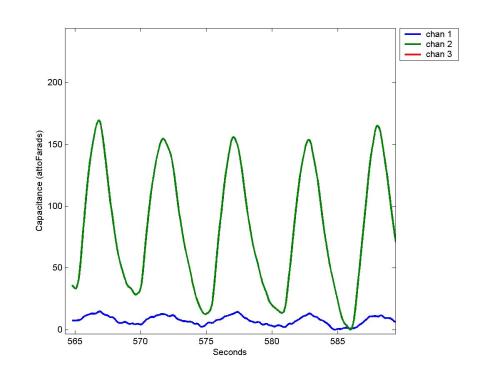Performance Evaluation
For the graphs shown here, the background subtraction time window is
equal to the graph
interval, so the lowest point on each sensor response is always
zero. The Y axis (labeled capacitance) is the increase in
capacitance above this minimum value. This is a change (motion)
detection mode, where only increases in the recent past have any effect
on the output.
Currently no object detection function is implemented, however
reasonably good results could be obtained by using a simple threshold
of 300 attofarads.
Sensor noise:
This graph shows the sensor noise under good conditions:

The noise floor is about 10 attofarads peak-to-peak, which corresponds
to a current change of about 4 picoamperes at the antenna.
When more
interference is present, the noise floor can increase by over an order
of magnitude.
In practice, the sensitivity is also severely limited by the need to
detect a very small relative change in the background
capacitance. The
noise floor is about 1/20,000 of the typical no-object capacitance, so
very small drifts in the background measurement can swamp the tiny
changes caused by small or distant objects.
The electronics were designed for high stability, and the residual
intrinsic electronic drifts are very well controlled by normalizing the
response according to the reference channel amplitude, so the measured
drifts are mostly due to actual changes in the capacitance caused by
small mechanical motions of conducting objects very close to the
sensor. This motion can be caused by thermal expansion or flexing
of
the mounting structure.
Person detection:
For detecting an adult, the reliable range is from contact up to about
1 meter. The noise limited detection range is about 1.6
meters. This graph shows the response of the three sensor array
to a person
walking in a along the length of the array at 1 meter, 0.7 meters and
0.35 meters:

We can clearly see the direction of the motion by the relative timing
of the peaks of response from each sensor, and can tell the approximate
position of the person at any given time by the relative strengths of
the sensor responses.
Respiration monitor:
To demonstrate the potential for other uses of the sensor, I used it to
measure chest motion due to breathing. The capacitive measurement
principle has been used in products to detect respiration, typically by
means of a large mat placed on the bed. Due to the high
sensitivity of this sensor, it can be placed some distance way.
This graph shows the response when the sensor is 30 cm away from the
chest:

My homepage | Up | Prev | email


